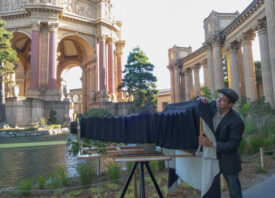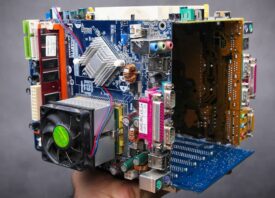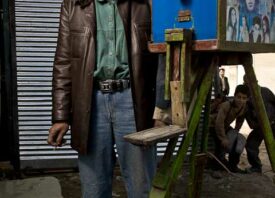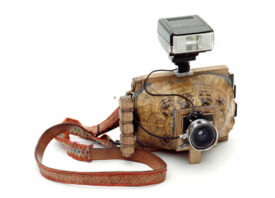Search this site
The Best DIY Camera Kits to Level Up Your Photography

In 2018, David Hancock set out to create pinhole cameras that anyone could build at home. He was inspired, in part, by a photographer friend who was navigating mobility challenges exacerbated by small camera dials. Hancock’s dream: make large format photography (4×5, 5×7, and 8×10) accessible for all through DIY cameras. After he raised $18,859 on Kickstarter, 5119 Cameras was born.
As of this writing, they’re almost entirely sold out. “I am down to my last one or two of each kit,” Hancock explains. “When those are gone, there will be no more of them.”
As evidenced by numerous successful Kickstarter campaigns in recent years—and the rise of passionate homemade camera builders—the demand for DIY cameras remains high. Established industry names and independent makers alike have rolled out new, beautifully-designed products for today’s photographers. The only downside? They usually sell out quickly, so get yours soon.
5119 Large Format Pinhole DIY Camera Kits

Available in multiple formats, these build-at-home camera kits are designed for everyone, from hobbyists to pros. “I developed them over a couple of years or so to be as good as I could make them,” Hancock tells us.
“The family includes four cameras, the smallest being the 4×5. Others are the 5×7, 8×10, and a 4×10 which also accepts two 4×5 backs to make diptych images. To the best of my knowledge, it’s the only camera ever made that can accept both 4×10 and two 4×5 backs.”


Jollylook Pinhole Instant Film DIY Camera Kit for Self Assembly

This vintage-inspired DIY camera was brought to life via a successful Kickstarter campaign. It’s made of eco-friendly materials and includes an exposure calculator, bellows, and a manual development unit for instant results. The kit itself contains 65 parts or pieces, which you assemble yourself. “Take wide-angle and zoomed images and play with brightness to get the perfect pinhole image that comes from this most basic form of photography,” the team suggests.


Lomography Konstruktor Flash SLR DIY Camera

This DIY camera by Lomography is an affordable option for all, costing just $39. “The Konstruktor Flash SLR DIY Camera allows you to demystify the process of analogue photography by building your camera from the ground up,” the team at Lomography shares. “In constructing it, you’ll begin to understand the intricate mechanics behind the analogue photos you shoot and have a ton of fun in the process. Building the Konstruktor Flash SLR DIY Camera is super-easy – it can usually be completed in one to two hours and, by the end, you’ll have a fully working SLR camera in your hands.”

Paper Shoot Plain Cork Camera Set

This DIY kit from Paper Shoot Camera empowers you to assemble a point-and-shoot digital camera at home. Once you build it, you can use it to shoot photos and video. The Paper Shoot has a few shooting modes available, allowing you to choose between four color settings: color, b&w, blue, and sepia. It’s really fast to build, requiring only about five minutes of your time. Think of it as a digital alternative to a disposable camera—without the plastic waste!

The Standard 4×5

Standard Cameras created this lightweight, affordable 4×5 to make large-format photography more accessible. “The Standard 4×5 initially began as a personal project,” the team shares. “In 2014, founder Drew Nikonowicz was uncertain if he would be able to afford his own 4×5 camera and equipment upon graduation.
“Through the remainder of his time at the University of Missouri’s School of Visual Studies, Drew began 3D printing parts for a homemade 4×5. He was encouraged when professors and colleagues took interest in the work, leading him to grow it into what is now Standard Cameras. By utilizing 3D printing, he was able to design parts quickly and cheaply without sacrificing quality. In addition, The Standard 4×5 is available as a download, allowing folks with 3D printer access to build their own from scratch.”
If you have access to a 3D printer, you can grab the download pack for The Standard 4×5 v1.0 right now. The Standard 4×5 v2.0 will be available shortly in three formats: as a fully-assembled camera, a DIY kit, and a download pack.
Pinsta-Pro 4×5 Pinhole Camera Basic Kit

PINSTA Camera is a bit different from the others in this roundup because there’s no assembly required (the camera itself has already been built). Instead, this little camera acts as a portable, DIY darkroom.
“Pinsta uses a peak quality double chemically etched pinhole to take impressive photographs onto paper or film,” the team explains. “Not only this, but Pinsta has a unique method for applying chemistry intravenously which means you can also develop your shots internally on the spot using refillable syringes.”
The camera (and kit) was created by Oliver New, who tells us, “I think the thing I love most about Pinsta is the sense of magic when you open the camera up to reveal a fully developed positive photograph.”

STA Camera
Dora Goodman Cameras

Dora Goodman Cameras creates gorgeous 3D-printed pinhole, medium format, and custom cameras, and their open-source model means anyone can get involved in the DIY film camera movement. The files are free to download, so all you need to get started is access to a 3D printer.
To get access to unique 3D-printed projects and limited edition Goodman camera designs that aren’t available anywhere else, you can also become a Patron. “Although our basic files to print your own camera will be always available open source free of charge, all the extra and super exciting accessories, mods, and projects will only be available for our Patrons,” the team shares. “As well, you will receive a 20% off discount code to our online shop that is valid for all our DIY kits.”
Further reading:
- 15 DIY Cameras That’ll Blow Your Mind
- Art Cameras Fashioned from Turtles, Armadillos, Horns and Books
- Portraits of Afghan Street Photographers Using Unique Wooden Box Cameras



